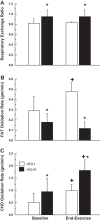Effect of high-fat and high-carbohydrate diets on pulmonary O2 uptake kinetics during the transition to moderate-intensity exercise
- PMID: 25277736
- PMCID: PMC4254835
- DOI: 10.1152/japplphysiol.00456.2014
Effect of high-fat and high-carbohydrate diets on pulmonary O2 uptake kinetics during the transition to moderate-intensity exercise
Abstract
Mitochondrial pyruvate dehydrogenase (PDH) regulates the delivery of carbohydrate-derived substrate to the mitochondrial tricarboxylic acid cycle and electron transport chain. PDH activity at rest and its activation during exercise is attenuated following high-fat (HFAT) compared with high-carbohydrate (HCHO) diets. Given the reliance on carbohydrate-derived substrate early in transitions to exercise, this study examined the effects of HFAT and HCHO on phase II pulmonary O2 uptake (V̇o2 p) kinetics during transitions into the moderate-intensity (MOD) exercise domain. Eight active adult men underwent dietary manipulations consisting of 6 days of HFAT (73% fat, 22% protein, 5% carbohydrate) followed immediately by 6 days of HCHO (10% fat, 10% protein, 80% carbohydrate); each dietary phase was preceded by a glycogen depletion protocol. Participants performed three MOD transitions from a 20 W cycling baseline to work rate equivalent to 80% of estimated lactate threshold on days 5 and 6 of each diet. Steady-state V̇o2 p was greater (P < 0.05), and respiratory exchange ratio and carbohydrate oxidation rates were lower (P < 0.05) during HFAT. The phase II V̇o2 p time constant (τV̇o2 p) [HFAT 40 ± 16, HCHO 32 ± 19 s (mean ± SD)] and V̇o2 p gain (HFAT 10.3 ± 0.8, HCHO 9.4 ± 0.7 ml·min(-1·)W(-1)) were greater (P < 0.05) in HFAT. The overall adjustment (effective time constant) of muscle deoxygenation (Δ[HHb]) was not different between diets (HFAT 24 ± 4 s, HCHO 23 ± 4 s), which coupled with a slower τV̇o2 p, indicates a slowed microvascular blood flow response. These results suggest that the slower V̇o2 p kinetics associated with HFAT are consistent with inhibition and slower activation of PDH, a lower rate of pyruvate production, and/or attenuated microvascular blood flow and O2 delivery.
Keywords: O2 uptake kinetics; high-carbohydrate diet; high-fat diet; muscle deoxygenation; near-infrared spectroscopy; substrate oxidation.
Copyright © 2014 the American Physiological Society.
Figures




References
-
- Bae JH, Schwemmer M, Lee IK, Lee HJ, Park KR, Kim KY, Bassenge E. Postprandial hypertriglyceridemia-induced endothelial dysfunction in healthy subjects is independent of lipid oxidation. Int J Cardiol 87: 259–267, 2003. - PubMed
-
- Beaver WL, Wasserman K, Whipp BJ. Breath-by-breath measurement of true alveolar gas exchange. J Appl Physiol 51: 1662–1675, 1981. - PubMed
-
- Behnke BJ, Kindig CA, McDonough P, Poole DC, Sexton WL. Dynamics of microvascular oxygen pressure during rest-contraction transition in skeletal muscle of diabetic rats. Am J Physiol Heart Circ Physiol 283: H926–H932, 2002. - PubMed
-
- Bergmeyer HU. Methods in Enzymatic Analysis. New York: Academic Press, 1974.
-
- Bergström J, Hermansen L, Hultman E, Saltin B. Diet, muscle glycogen and physical performance. Acta Physiol Scand 71: 140–150, 1967. - PubMed
Publication types
MeSH terms
Substances
LinkOut - more resources
Full Text Sources
Other Literature Sources
Medical
Miscellaneous

